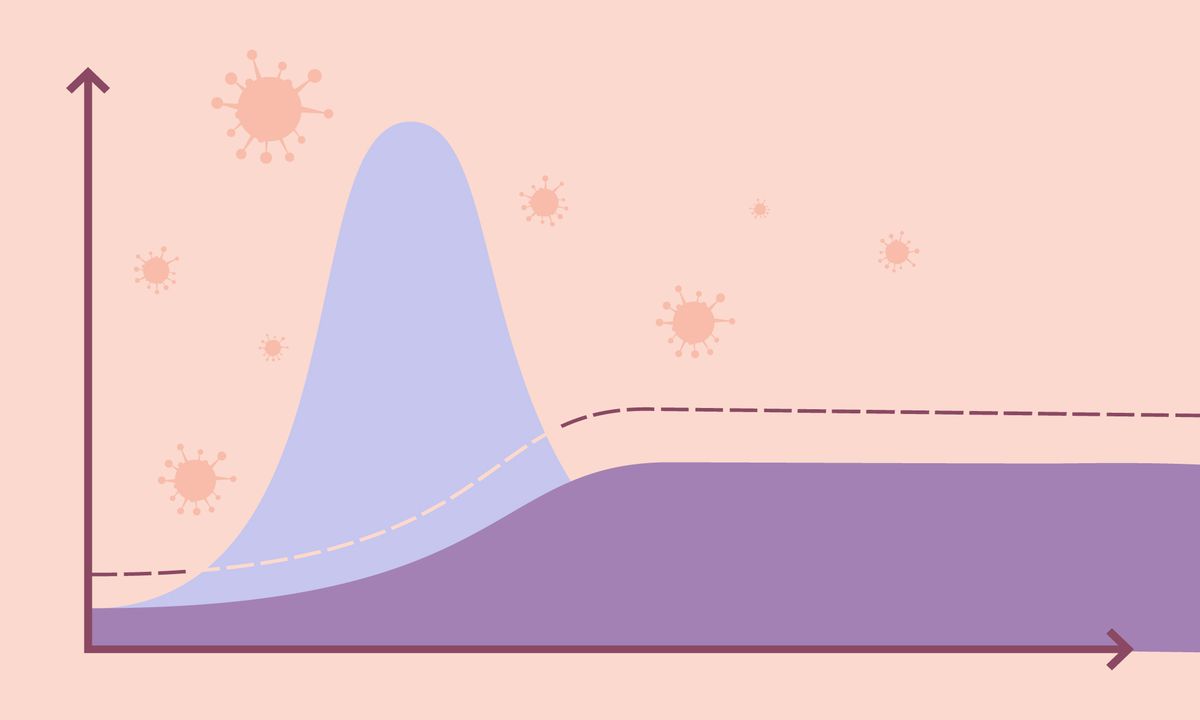

As the US prepares to enter into its third winter season dealing with COVID-19, an unanswered question—first asked back in the earliest days of the pandemic—remains: When will it be over? Unfortunately, the answer may be "never"—many experts no longer believe the virus will ever be eradicated, and instead, will become an endemic disease.
The thought that SARS-CoV-2 (the virus that causes COVID-19) will become an endemic virus or disease—one that has a constant presence in a community at lower levels—isn't exactly a new one. In May 2020, the World Health Organization (WHO) put this theory on the table. "This virus may become just another endemic virus in our communities, and this virus may never go away," Michael Ryan, MD, MPH, executive director of the WHO's Health Emergencies Programme, said in a press conference at the time.
Just a few months later, in November 2020, the health officials in the US followed suit: "We need to plan that this is something we may need to maintain control over chronically," Anthony Fauci, MD, director of the National Institute of Allergy and Infectious Diseases (NIAID), said in a webinar with Chatham House. "It may be something that becomes endemic, that we just have to be careful about."
One community in particular has already reportedly reached endemic status, too: Portugal is now dealing with "endemic COVID-19," according to the Wall Street Journal. It's the result of being the country with the highest COVID-19 vaccination rates in Europe. Though Portugal was ravage by the Delta variant in early 2021, the country is now in a "transitional period" of moving from pandemic to endemic: "Nobody will ever forget this past January, but now COVID is endemic and we need to learn to live with the virus," Maria Mota, executive director of Lisbon's Institute of Molecuar Medicine told the WSJ. "Almost the whole population is vaccinated here and the virus still circulates, showing it won't go away."
The US may not be there quite yet—but how will we know when it is, and what might endemic COVID-19 in the US look like? Here's what experts think.
When is a disease considered ‘endemic’?
Right now, COVID-19 is still considered a pandemic—a sudden increase of disease activity that spans across several countries, and affects a large number of people, according to the Centers for Disease Control and Prevention (CDC). "A pandemic is when there is a growth in the disease that is huge, exponential," Perry N. Halkitis, PhD, dean of the Rutgers School of Public Health, tells Health. "The growth increases at a very, very large rate and each day cases grow more than the day before."
Endemic disease is on the other end of that spectrum. The CDC says endemic "refers to the constant presence and/or unusual prevalence of a disease or infectious agent in a population within a geographic area." Endemic doesn't necessarily mean the desired level of a disease, or even a low level; instead, it means a level that is observed over a period of time and stays relatively constant—it's basically a baseline or expected level of disease.
"Endemic means that it will be a part of our regular type of viruses that we will be seeing, generally on an annual basis," Pedro Piedra, MD, professor of molecular virology and microbiology at Baylor College of Medicine, tells Health. The seasonal flu, for example, is endemic to the US—it's something that we see ebb and flow during a predictable time period each year. When a virus or disease is endemic, the levels will generally be consistent but may [increase] during certain times of year, Dr. Piedra says.
When will COVID-19 become endemic—at least in the US?
It's tricky to predict and debatable, given that there's not one set benchmark in place to describe when a virus like COVID-19 officially goes from being a pandemic to endemic.
One thing that is often looked at is the reproduction number—usually known as R0 and pronounced "R-naught"—which is a mathematical term that "gives an indication of how extensively a pathogen is spreading," Halkitis says. The CDC says a disease's reproduction number is the number of secondary cases that comes from a single case.
Of course, that's a really hard number to nail down. According to a study published in the CDC journal Emerging Infectious Diseases in July 2020, research put the reproduction number of COVID-19 at a median of 5.7—roughly, that means for every one person infected with COVID-19, they spread the disease to about five or six other people.
Since then, that number has come down: Epiforecasts.io, which is run by the Centre for Mathematical Modeling of Infectious Diseases, currently puts the reproductive number at 0.96. That's a good thing, Halkitis says. "When it's more than one, that means it's spreading more rapidly," he says. However, he points out that the reproductive number can vary by region, depending on what's happening with current COVID-19 case counts. When case counts go up, the reproductive number goes up, too, he says.
If the number can stay stable at or below one, it can signal that COVID-19 is shifting to an endemic status, Halkitis says. In fact, he argues that COVID-19 is already endemic in the US "The disease has gone from pandemic to endemic, meaning it will continue like a steady beat to exist in our country in certain areas and it's not going to disappear completely, but there is more of an understanding that it continues to exist in our midst," he says.
Infectious disease expert Amesh A. Adalja, MD, a senior scholar at the Johns Hopkins Center for Health Security, tells Health that he also thinks COVID-19 is already endemic. "I do consider COVID-19 endemic now," he says. "It means that this is an ever-present virus that people will need to adjust to. This virus was always destined to be endemic—the only aspect that will change over time is its ability to compromise hospital capacity."
Dr. Piedra, however, is not quite so convinced—he says we're not quite there yet with an endemic status for COVID-19. "We still have a lot of susceptible individuals in our communities," he says. "The question right now is, 'When will we have the next outbreak?' If you continue to see waves throughout the year and not just, perhaps, one wave a year, then we aren't there yet."
Dr. Piedra says that there "needs to be an underlying immunity," either from enough of the population being vaccinated against COVID-19 or from actually having had the virus to get to the point where case counts will level off and stay that way. "Once the global population has seen COVID-19, it will become a seasonal virus," he says. "Whether it increases once a year or every other year is going to depend a lot on susceptibility." (His prediction: This wil happen within the year.) But, Dr. Piedra says, "if we're all vaccinated, we can prevent the next wave from coming or reduce the significance of a future outbreak even more."
And if you're looking for a big announcement of endemic COVID-19, you probably won't get it, says Halkitis, given that there are no official markers for when a disease "officially" becomes endemic. "We don't ever have a raising of the flag or announcements on the news that a disease has gone from a pandemic to endemic," he says. "It's more of an understanding that it continues to exist in our midst."
The information in this story is accurate as of press time. However, as the situation surrounding COVID-19 continues to evolve, it's possible that some data have changed since publication. While Health is trying to keep our stories as up-to-date as possible, we also encourage readers to stay informed on news and recommendations for their own communities by using the CDC, WHO, and their local public health department as resources.
Source: Read Full Article